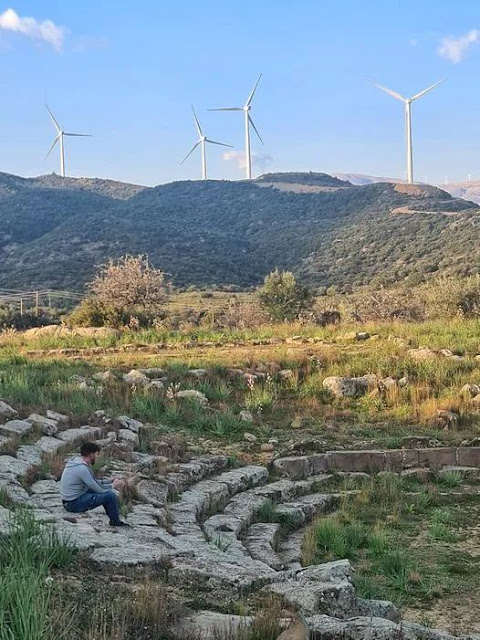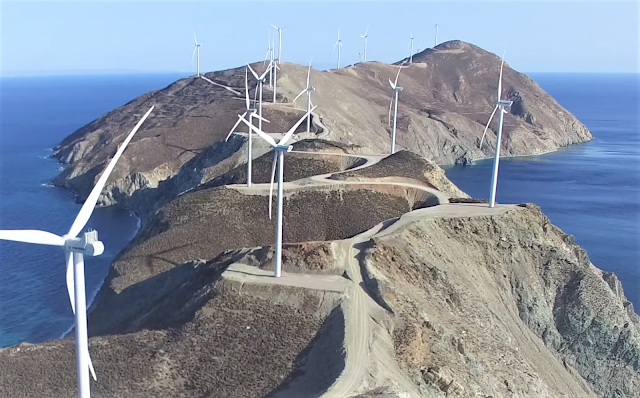Industrial wind farms in Greece
Winter 2022
Scenic landscape conservation in Greece...
With its spectacular relief and geographical diversity, Greece is definately on of the richests countries in Europe in terms of scenic landscape resources. However, these landscapes are, as one might expect, taken for granted!
Just like biological riches, these landscape riches can be plundered, polluted and degraded. Landscapes can be desecrated by all sorts of modern developments - poor planning, wrongly-placed infrastructure, poor land decisions - industrial wind farms in wild land, for example.
Here I present thoughts and photos of industrial wind farms in wild lands, in Greece, today.
The first voice you may hear is: What a hypocrit, typically a hypocrit! (I have worked for industry for decades in environmental impact studies, including wind farms - so I should be clear about that!).
Not in my back yard!
But is it a question of the NIMBY syndrome? I don't think so...
Here I present the horror of desecrating wilderness, wild land, important natural areas and outstanding scenic resources. I am not discussing wind turbines in general. I am talking specifically about mis-placed, poorly planned industrial wind turbine developments. We are talking about the ruin of landscapes - and not just by the turbines themeselves (think power-lines, roading, rock-quarrying, infrustracture of all kinds - all associated with the industrial wind farms in the mountains.)
Many of these landscapes are part of local identity, sometimes they are outstandingly unique and protected. Often within nature protected areas (within the Natura 2000 network) or near emblematic scenic places. Famous historical, mythological, archaeological sites. Sometimes there in nobody's backyard: wilderness mountain crests, unseen by most. Also on far off islets. S
o its not just NIMBY. Often, it is simply misplaced industry. Anarchy in planning. And with dirty politics included.
So, how bad is the situation in Greece?
Its shameful, ridiculous and criminal!
I think Greece is a special case for this kind of problem - a "planning accident" of a grand scale.
Wind farms have expanded during the last 10 years; and they keep expanding. Broad-scale and wholesale destruction of landscapes and protected areas is taking place in the name of alternative wind-power development.
What wind farms and their infrastructure may affect:
- Biodiveristy, wildlife habitats
- Designated protected areas (e.g. Natura 2000 site integrity)
- Wilderness (roadless areas that are remote and of high natural or cultural integrity)
- Traditional cultural landscapes (land-use patterns)
- Cultural Ecosystem Services (including non-material benefits provided by natute to human society)
- The tourism industry
- Ecotourism and alternative tourism promotion
- Aesthetic qualities
Some photos and maps and a recent paper of ours illustrate the situation today; I believe it is an important concern.
 |
| On Mount Kytheron with the Corinthian Gulf. (Photo courtesy of Nikos Nezis). |
 |
| Same area as above; Mount Kytheron with the Corinthian Gulf in the distance. (Photo from the internet). |
 |
| Close-up in the Acarnanian Mountains (Photo from the internet). |
 |
| Same place above, from afar. The Acarnanian mountains with Perganti peak crowned by the mega-turbines as seen from afar; same location as previous photo. (Photo by Vassilis Wooseas). |
 |
| Wind park with gigantic industrial turbines on Mount Valtou in the Pindos range- imporantant wilderness areas and critical for vultures. Seems absolutely UNREAL! (Photo from the internet). |
 |
| The "wind-factory" near Molaous (as above) in Monembasia municipality, Peloponnese. Dystopian or ecological landscape - you choose...(Photo from internet). |
 |
| One of the large parks near Kalavrita in the Northern Peloponnese at 1600 m. elevation (photo from recent video of Terna Green Energy). |
 |
| In the Argolid, Peloponnese. Again mountain ridgelines. Formerlly, no roads, no access, endemic plant hotsports. Sky islands. Desecrated wildernesses. |
 |
| Agioi Apostoloi on Euboea Island (same area as abome). Looking northwards - Lake Dystos on the middle Left. (Photo from the internet). |
New Vestas power plant being errected somewhere in the Aegean. Note the cultural landscape of high-stone walls and terraces. (Photo from the internet).
 |
| Near Antia in Southern Euboea Island above the brilliant blue of the Aegean. |
 |
| At 1000 m elevation on Mount Ochi, Southern Euboea. Are there significant effects on the biodiversity uniquness of these "sky islands" in the Aegean? |
Drone photograph of a windfarm on Kephalonia Island; the peak is no longer a wilderness islet but a lovely industrial site and look-out: now easily accessible to tourists and local recreationists... (Photo from the internet).
HOW SERIOUS IS THIS ISSUE IN GREECE?
My sincere opinion: After working in Greece for many many years and having witnessed real change in the '80s and '90s, I believe that the issue of industrial windfarm mass developement is the single most important threat to biodiversity and landscape integrity in this country in recent times. It cannot be eclipsed by anthing - even considering other important threats such as urban and coastal building sprawl, ongoing wetland and river degradation, and mega-wildfires. We are talking about a step-change in wild land change in a country. Greece really did have wild land until just a decade or so ago in many areas that are now slated to become wind farms (mountain crests, upland wilds, off-shore islands). This issue is seriously big and harmful. And it has been overlooked.
 |
| The level of the threat? Where is the industry being concentrated-promoted? This is the scence in 2020 from Vlami et al. 2020. Read paper in link below: |
Please read our review for a 'conservative' analysis of the windfarm threats to protected areas in Greece:
MORE photos, real scenes from Greece....
 |
| Nightmare landscape change (internet photo). |
 |
| Mount Ochi, Southern Euboea (Author's Photo). |
 |
| These ones are abandoned; Southern Euboea (near Kastri). (Author's photo). |
 |
| Near Antia on Euboea island (Author's photo). |
 |
| Archeological sites such as Ancient Macynia in western Greece are also aesthetically affected (Photo from Internet). |




















